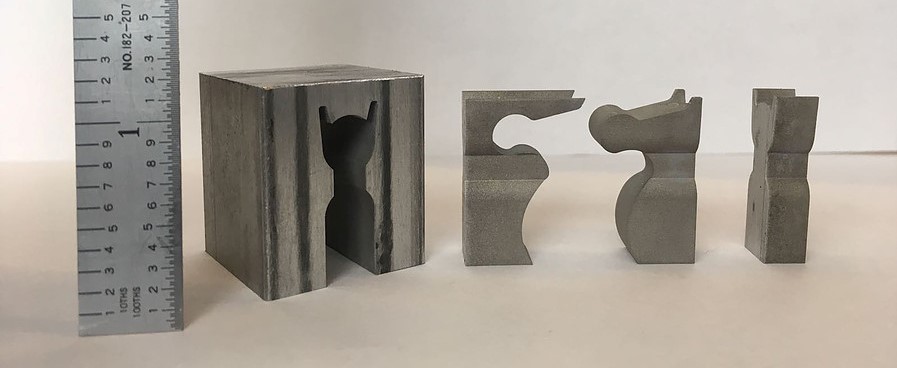<br>
[MAS.865](../index.html) > [subtractive](index.html)
## Electrical Discharge Machining (EDM)
[EDM](https://reprap.org/wiki/Electrical_Discharge_Machining) uses electrical discharges between two electrodes to remove material.
* One electrode is the tool, the other is the workpiece
* Electrodes are separated by a dielectric liquid and subject to an electric voltage
* As the intensity of the electric field in the volume between the electrodes becomes greater, it causes a dielectric break down of the liquid, and produces an electric arc
* Flushing: New liquid dielectric introduced, enabling the solid particles (debris) to be carried away and the insulating properties of the dielectric to be restored
### Wire-cut EDM
<img src='http://en.chenggongyi.com/ueditor/php/upload/image/20180531/1527697216958721.jpg' alt='wire edm'>
_Operating principle for wire-cut EDM (Image from [Novick](http://novickglobal.com/fnews-49/Advantages-of-Wire-EDM-Machining.html))_
* Emerged in the mid-20th century for making dies from steel.
* The tool electrode is a wire
* The wire (usually brass) is wound between two spools such that the part of the wire that is active is constantly changing, in order to prevent erosion/breaking of the wire.
* Kerf as small as 0.021 mm (for a 0.02 mm wire)
<!-- * [Making precision parts](http://www.intellectualventures.com/insights/archives/ivs-favorite-inventions-the-babbage-machine/)
<br> -->
* <a href='http://fab.cba.mit.edu/classes/865.15/people/will.langford/11_final/index.html'> Will Langford's Wire EDM machine</a><br>
<img src='https://mtm.cba.mit.edu/2015/2015_desktop-wedm/images/dwedm2_01.jpg' alt='wedm' width='600'>
* <a href='https://fab.cba.mit.edu/classes/S62.12/people/peters.ben/mass62-final-notes.html'> Ben's 2012 EDM machine </a> uses graphite from a mechanical pencil instead of wire.
* [Curved hole EDM drilling using suspended ball electrode](https://www.sciencedirect.com/science/article/abs/pii/S0007850617301257)<br>


### Die-sink EDM
<img src='https://upload.wikimedia.org/wikipedia/commons/c/c9/EDM_scheme.png' alt='sink edm' width='600'>
_1 Pulse generator (DC). 2 Workpiece. 3 Fixture. 4 Dielectric fluid. 5 Pump. 6 Filter. 7 Tool holder. 8 Spark. 9 Tool._
* Sinker EDM, also called ram EDM, cavity type EDM or volume EDM, consists of an electrode and workpiece submerged in a dielectric fluid (typically oil)
* Several hundred thousand sparks occur per second, with the actual duty cycle carefully controlled by the setup parameters.
* Modern controllers monitor the characteristics of the arcs and can alter parameters in microseconds to compensate.
* <a href='https://www.homemadetools.net/homemade-edm-machine'>Homemade EDM machines</a>
### EDM hole popper
<img alt='small hole EDM' src='https://www.researchgate.net/profile/Magdalena-Machno-2/publication/280621074/figure/fig11/AS:667921013563407@1536256187519/Scheme-of-small-hole-EDM-drilling-process-a-and-scheme-of-machining-area-during-EDM.ppm' width='400'>

## ElectroChemical Machining (ECM)
Electrochemical machining (ECM) is a method of removing metal by an electrochemical process. It is normally used for mass production and is used for working extremely hard materials or materials that are difficult to machine using conventional methods.
<img alt='ECM' src='https://upload.wikimedia.org/wikipedia/commons/thumb/4/48/Electrochemical_machining_%28ECM%29.svg/1920px-Electrochemical_machining_%28ECM%29.svg.png' width='600'>
_Electrochemical machining principle (Image from Laurensvanlieshout)_
* Used to make complex shapes with good surface finish (e.g. turbine blades)
* Widely used for deburring
* Complex concave curvatures can be produced using concave tools
* No direct contact between tool and work material, no wear
* A fluid is used as a medium between the tool and the work piece (conductive for ECM and dielectric for EDM)
* Both tool and workpiece must be conductive
* High power consumption
## Etching
Etching is the process of selectively protecting parts of a metal surface and then incising a pattern into it
using acid or mordant. <a href='https://en.wikipedia.org/wiki/Etching_(microfabrication)'>From Wikipedia</a>
Etching is used in microfabrication (also called photochemical machining) to chemically remove layers from the surface of a wafer during manufacturing. Etching is a critically important process module, and every wafer undergoes many etching steps before it is complete.
<img src='https://www.hitachi-hightech.com/image/global/products/device/semiconductor/07_il01.gif' alt='etching' width=400>
For many etch steps, part of the wafer is protected from the etchant by a "masking" material which resists etching. In some cases, the masking material is a photoresist which has been patterned using photolithography.
* Wet etching: The first etching processes used liquid-phase ("wet") etchants. The wafer can be immersed in a bath of etchant, which must be agitated to achieve good process control.
* Plasma etching: Modern processes avoid wet etching, and use plasma etching instead.